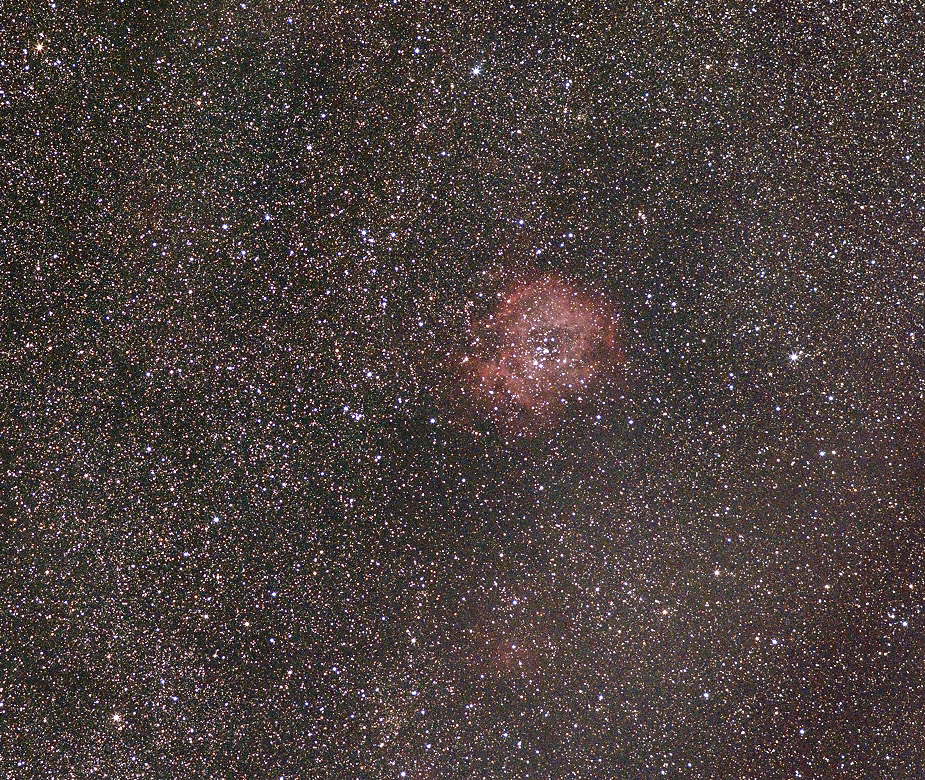2024
March
30
|
Holy Saturday
I've not yet said anything here about the holiest week in the Christian calendar,
which ends tomorrow. But let me share my Good Friday reflection from Facebook yesterday,
which non-Christians may also appreciate as a moral insight.
God wants us to reject evil, not paper over it with a layer of cynicism or insincerity.
Repenting of a sin means saying, "I wish I had not done it, because it was wrong," not "I'm embarrassed that it came out clumsily," nor "I had the same bad luck other people have," nor "That wasn't the real me."
This implies, by the way, that embarrassments and bad outcomes are not necessarily sins. Often we have to pick apart a complex situation to figure out what part of it, if any, actually constituted disobedience. Honest errors aren't sins unless you neglected your duty to get good information and think carefully. But avoiding sin is not the same as pleasing everyone and having every interaction go smoothly.
A saint is not the same thing as a smooth people-pleaser.
And "That wasn't the real me," popular with celebrities, doesn't make a lot of sense when considered carefully.
Are you repenting of your own sins or someone else's?
Permanent link to this entry


|
2024
March
29
|
Familiar territory
These days, when I return to astrophotography after a month or two away from it,
there are new versions of several pieces of software.
Besides, I need to make sure all the equipment works for a new season.
So I end up taking pictures of familiar objects before branching out
to anything unexplored.
With that in mind, last night I got out my iOptron SkyTracker, Canon 60Da, and Sigma
105-mm f/2.8 DG EX lens, and took aim at the belt of Orion.
Due to a mistake setting the intervalometer, I got only a quarter as
many exposures as I wanted, but the lens and tracker served me well.
Here's a stack of ten 30-second exposures of the Belt of Orion at f/4
and ISO 800:
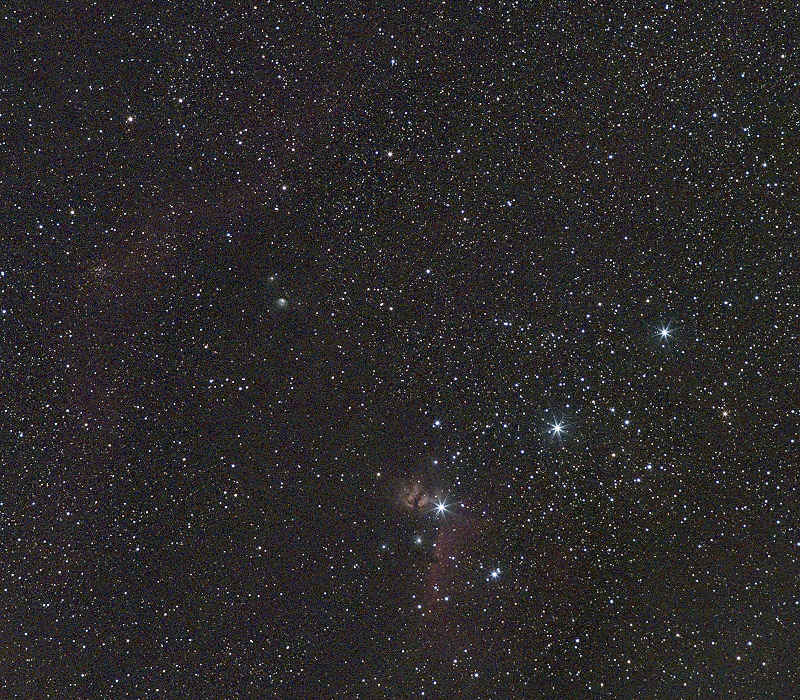
This is my farewell to the winter constellations this year.
The three bright stars are Orion's belt, and an S-shaped arrangement
of fainter stars snakes through it right of center.
The Flame Nebula is at its left, and the Horsehead (not very equine-looking here)
is a notch in the red nebula that hangs down from it.
To the upper left of the belt are the bright white comet-like
reflection nebula M78; farther to the upper left, the broad
faint red streak of Barnard's Loop.
The new gradient elimination tool in PixInsight served me very well.
Permanent link to this entry
Rosette Nebula
Here's something more ambitious. With the same equipment, I took 40 exposures
of the field of the Rosette Nebula in Monoceros.
(I was actually intending to get 160, but 40 seem to be enough.)
|
2024
March
24
|
A "mineral moon"
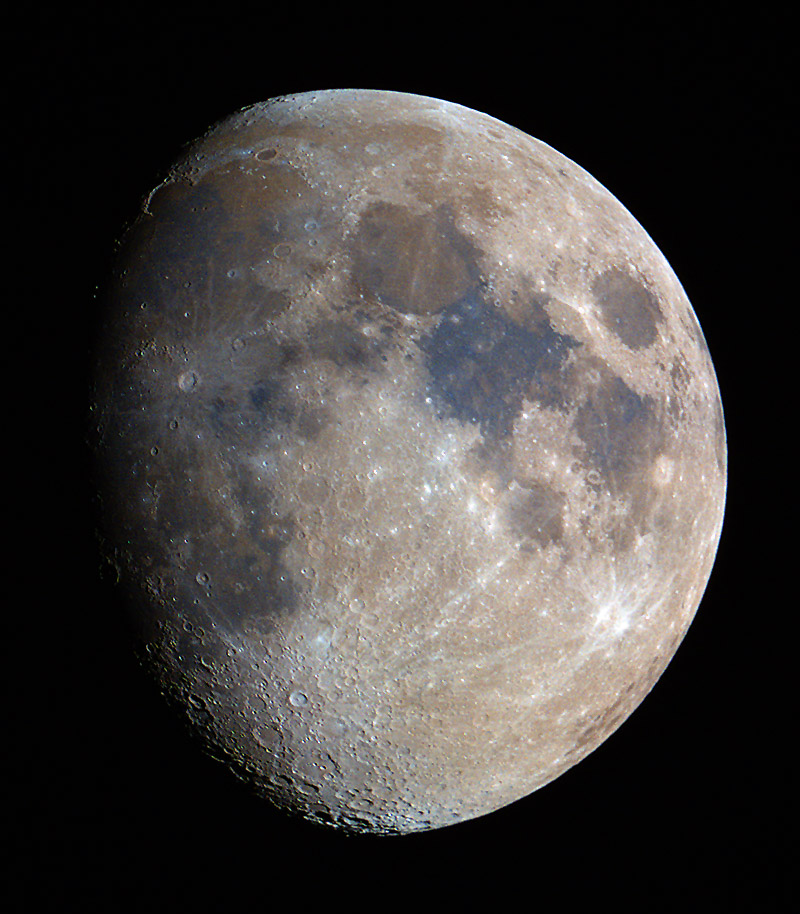
This is what amateur astronomers now call a "mineral moon," an image of the moon
with the color saturation boosted to show the different types of minerals on the moon's
surface, especially the blue of Mare Tranquillitatis.
I took it on the evening of March 20; it's a stack of nine 1/200-second exposures on my
Canon 60Da at the f/10 focus of my vintage Celestron 5.
The saturation was boosted in Photoshop.
Although others must have thought of similar techniques around the same time, I had a large
role in getting people started photographing the moon this way.
There was an example in my Astrophotography for the Amateur, second
edition, 1999, where I digitized a film image and then boosted the saturation.
Results are much more satisfactory with a digital camera,
and I wrote an article about that for Make Magazine, Volume 24, October, 2010
(click here
to see it).
An advanced telescope and camera are not needed — use anything that gives you a good
full-color image of the moon, open the picture in Photoshop, and then hit Image, Auto Color, and then
Adjustments, Hue and Saturation, and turn up the saturation.
Permanent link to this entry


|
2024
March
20
(Extra)
|
Eclipse safety: Test your eclipse glasses
We have a solar eclipse coming up on April 8.
Viewing it improperly can permanently damage your eyes.
These injuries are now rare, but I've been studying them to find out what
is still going wrong, and here's the word for this year:
If you're going to use eclipse glasses, test them first.
The reported injuries have happened largely to people who were using some
kind of "eclipse glasses" that were not safe — maybe dark sunglasses,
maybe something entirely different.
I have heard of no injuries with eclipse glasses that passed the following test:
Put the glasses on and look around.
You should only be able to see the sun, very bright reflections of the sun on metal,
and possibly some of the brightest electric lights.
If you can see anything else (the ground, cars, people, etc.), you do not have
safe eclipse glasses.
This is only a test for manufactured eclipse glasses and solar viewing filters.
It is not a test for improvised or homemade filters!
I suspect the reported eye injuries actually came from people using dark sunglasses
or something else not very much like eclipse glasses at all.
(Already in 2017 I came across people who had heard of eclipse glasses
and thought they were sunglasses.)
There have been reports of eclipse glasses with counterfeit trademarks or
dubious origins, but the real question is, are they dark enough?
That's what the test is for.
If you don't want to worry about eclipse glasses,
make a pinhole projector
out of two paper plates or scraps of cardboard.
I am co-author of the
Cambridge Eclipse Photography Guide and have
been quoted by NASA on eclipse safety.
Feel free to share this link.
Permanent link to this entry


|
2024
March
20
|
Historic moment
Please pardon the 8-day hiatus; we've been busy. But this is a historic moment.
Right now, for the first time since her Dec. 25 fracture, Melody is running an
errand by car — taking Sharon to massage therapy.
In a few minutes they'll be back and I'll hear how it went.
Back to normalcy!
Permanent link to this entry
Bitcoin has matured
About seven years ago, I was very skeptical about Bitcoin, and so were a lot of other
people. But I think Bitcoin has matured. Here, in brief, are some of my current
thoughts (which are still very much undergoing development).
- I'm much less worried about a technical or security failure than I used to be.
Enough time has passed. This doesn't mean failure is impossible, but people with
incentives to break the system have had enough time to try that we can have some
confidence it's not easy (and, because of growth, is getting steadily harder).
- Use of Bitcoin has increased, and that, in itself, confers reliability.
- Bitcoin is not a thing of value; it is a financial service.
It is fundamentally a secure recordkeeping and transaction-processing system.
- Actually, that is also what national currencies are; we use dollars because
we trust our government to control the supply of them and maintain a well-regulated
banking system.
- And even gold isn't really valuable in itself. It has some value because of its desirability for the
arts and industrial uses, but mostly, gold is simply an easily authenticated,
non-perishable material to use as tokens. You can't eat it or heat your house with it.
It is a financial tool, in my opinion an obsolete one.
- As national currencies develop more digital infrastructure, the privacy of Bitcoin
may become more important. It seems likely that national currencies will evolve into a
system where governments keep records of individual transactions. Many of us would not
be comfortable with that — not that we're up to no good, but that we don't want
Uncle Sam involved in all use of money. Bitcoin provides an unprecedently powerful
way to maintain privacy and accuracy at the same time.
I don't think Bitcoin is perfect — I am interested in commodity-based currencies,
for instance — but I do think it represents a useful alternative.
We may want to disengage from the notion that money is only issued by governments.
Permanent link to this entry
Workshop hint: Hot-melt glue and hot-air gun
Things I learned on YouTube: If you have a hot-air gun (especially the kind used for
surface-mount soldering), you don't need a hot-glue gun. Just heat things up with hot
air and use the glue sticks like solder. You can cut them into thin slivers if that's
more convenient.
Why didn't I think of this myself?
Permanent link to this entry


|
2024
March
12
|
Four years of COVID
Four years ago yesterday was
America's "last normal day,"
the day the COVID cancellations and lockdowns started,
the day our lives (indeed, the world's lives) changed
irreversibly. I put March 11, 2020, on a level with
September 11, 2001, and December 7, 1941.
Here are charts of the case rate and death rate in Georgia, whose
statistics resemble those of the whole country.
These are from the Georgia Department of Public Health
and, as I've done before, I edited the case rate chart to take out
a false spike from a data reporting problem in April, 2022.
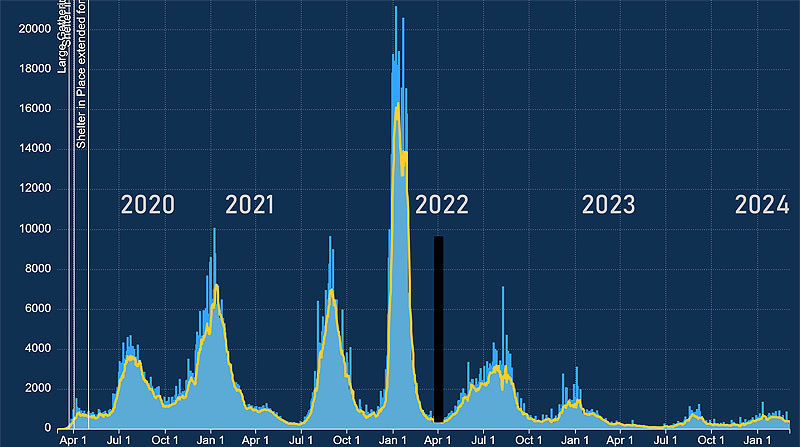
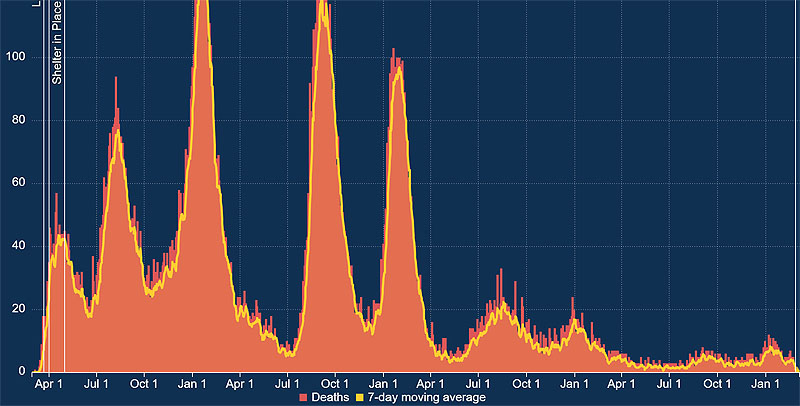
You see the regular January-February and August-September spikes.
I had COVID in February 2024 (very late in the game, after several
vaccinations) and, probably, also in September 2021 (without a positive
test, but my sense of smell was damaged, a classic COVID symptom).
Thanks to vaccinations, I was not seriously ill either time, just
inconvenienced.
As I've said before, I'm sad that we lost so much of our regular routine.
For the first time since middle school, I got accustomed to spending whole
days at home. I've had unprecedented success in my work, but at the same
time, I miss the old days, and too much of pre-COVID life isn't coming back.
As I've said repeatedly, Melody and I miss the casual contact with
familiar people at work and church and even in stores and restaurants,
people we did not know well enough to seek out socially, but who were
stable parts of our lives. The old routine is gone; there has been a lot
of turnover of restaurants and businesses; and it's almost as if the whole
town had been replaced around us.
But part of the change is us — we just don't get out as
much as we used to. And part of that comes from the success of my
consulting activities and more efficient use of time.
I am very sad that some of my friends died of COVID. I am also sad
that some of them lost their rationality; one went fully into QAnon;
a few others became blowhards, trying to force me to agree with their
non-expert opinions and not listen to real experts.
In my research on schizophrenia, some years back,
I noticed (but did not study scientifically) an important difference between
rational thinking and delusion-prone thinking:
Everyone can consider strange possibilities, but delusion-prone people
can't let go of them.
Or to put it another way, rational people can abandon a guess once they see
that it doesn't fit the evidence.
Was the COVID lockdown an evil government's way of oppressing us?
I could imagine such a thing happening, but I could also see that it
didn't fit the observable facts at all.
Delusion-prone conspiracy theorists, on the other hand, couldn't let go of the
idea once they had thought of it. Its emotional appeal made it impossible
to test rationally.
And suddenly it became fashionable to be delusion-prone.
I think this overall loss of rationality is one of the things
that led to the insurrection of January 6, 2021.
By the way, have you noticed drab post-COVID decor? It seems all the buildings are
being painted cream-colored, gray, black, and maybe white or very deep purple.
The vivid colors of the 1970s and the earth tones of the 1980s seem to be going away
as fast as people can replace them.
The change even extends to people's clothing.
I am told that in the 1920s, most 19th-century wooden houses were painted white,
giving the impression (certainly clear to me as a child in the 1960s) that they
had always been that way. This is similar.
Permanent link to this entry


|
2024
March
9
|
"Swans on the Lake," by John Thompson
When I was in high school, I started piano lessons, but due to family circumstances I had to stop after about, I think, 3 lessons.
Because I was an older beginner and had already been playing the piano with one hand to some extent, the teacher started with the Grade 1 book but didn't
take me through every song. Instead, she chose to start at a song that seemed to be at about the right level.
It was indeed a pretty song, considering how simple it is, and it demonstrates the tune being passed back and forth between the right and left hands. I never forgot the tune. I think this was actually the only song I played as part of the lessons.
Two days ago I found it online, and yesterday I managed to play it on our little electronic keyboard. Not perfectly on the first try, of course.
But here's a proper performance of it by a teacher:
|
2024
March
7
|
Your what really turned blue?
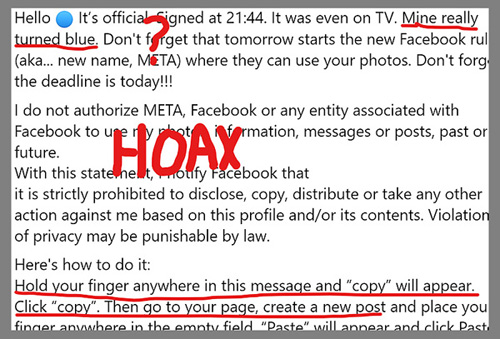
A familiar hoax is going around Facebook again.
The people who spread it must not even
read the things they're posting, or they'd
balk at the strange sentence "Mine really turned blue" in this one.
The next time I see one, I'm going to reply: "I see that a scammer
has tricked you into posting lies." Because that's
what is happening.
I got an unexpectedly helpful response from someone who saw my Facebook posting about this.
She said, "I was almost taken in because it looked so convincing."
Well, here's a basic adult life skill:
You can't tell whether something is true by whether it "looks convincing."
You have to check against facts from other sources!
Permanent link to this entry


|
2024
March
5
|
Twenty years
I've just started a new month in the Daily Notebook for the 241st time,
still doing it by editing raw HTML.
The Daily Notebook has been going for 20 years; it started on
March 3, 2004.
It's not the longest-running blog in the world, but it's one of the longer-lived ones.
In these busy times, I didn't get to write an entry on the exact 20th anniversary.
Nor did I mark yesterday, March 4, as the 50th anniversary of a well-remembered
celebration of Exelaunei Day
(an inside joke among Greek scholars)
at The University of Georgia in 1974.
Professors Nethercut and Best are no longer with us, but I remember.
Permanent link to this entry


|
|
|
This is a private web page,
not hosted or sponsored by the University of Georgia.
Copyright 2024 Michael A. Covington.
Caching by search engines is permitted.
To go to the latest entry every day, bookmark
https://www.covingtoninnovations.com/michael/blog/Default.asp
and if you get the previous month, tell your browser to refresh.
Portrait at top of page by Sharon Covington.
This web site has never collected personal information
and is not affected by GDPR.
Google Ads may use cookies to manage the rotation of ads,
but those cookies are not made available to Covington Innovations.
No personal information is collected or stored by Covington Innovations, and never has been.
This web site is based and served entirely in the United States.
In compliance with U.S. FTC guidelines,
I am glad to point out that unless explicitly
indicated, I do not receive substantial payments, free merchandise, or other remuneration
for reviewing or mentioning products on this web site.
Any remuneration valued at more than about $10 will always be mentioned here,
and in any case my writing about products and dealers is always truthful.
Reviewed
products are usually things I purchased for my own use, or occasionally items
lent to me briefly by manufacturers and described as such.
I am no longer an Amazon Associate, and links to Amazon
no longer pay me a commission for purchases,
even if they still have my code in them.
|
|






